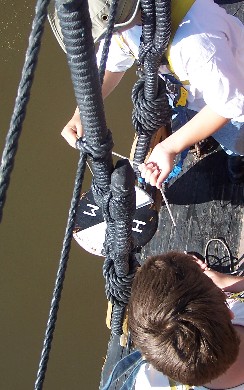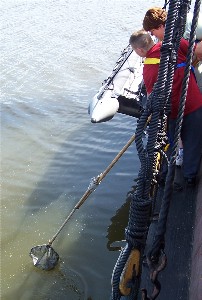 |
|
|
River
Science
Page One Page
Two
|
|
|
When Henry Hudson and his crew first sailed up the Hudson River in 1609, they marveled at the region's lush wilderness, pondering the numerous possibilities for trade it presented. Today, the Hudson River Valley still rewards close examination. Using the Half Moon as a floating laboratory, our student crews spend some of their time onboard studying a wide range of ecological principles. Although the crew of the original Half Moon possessed some of the tools we use, our students take advantage of modern instruments to further their knowledge of the scientific principles at work all around them.
|
Quicklinks:
|
|
Current Speed
The Hudson's current can notably affect the Half Moon's navigation; for example, if we sail with the current, it can speed us along, or it can slow us down when sailing against it. It's also important for local wildlife, since some species thrive in slow currents, while others prefer more rapid waters. The Hudson is a tidal river from its mouth in New York Harbor all the way up to Cohoes, so the speed of its current can vary considerably -- even reverse itself -- as the tides ebb and flow. The student crew uses wood chips (being collected by Mr. Swartout, above) to measure current speed. Students examining current speed as part of their projects, such as Charles and Nicole, would then toss a (biodegradable) chip into the river, timing it as the current carried it between two fixed points (such as the length of the weatherdeck) to calculate its speed.
|
|
|
As one might well expect, wind speed is an important consideration for a sailing ship like the Half Moon. Charles, Kristin, and Samantha focused on wind speed in their projects, using hand-held anemometers (as Samantha is doing, above) to take measurements, recording peak and average wind speeds throughout the day. The students also compared wind speeds on the weatherdeck with those recorded at the same time in the tops. They found that the wind was consistently stronger higher in the air, and proposed several theories to explain their findings. Checking wind direction is quite a bit easier -- just look up at the flags!
|
|
|
|
|
| Water clarity (or
turbidity) is determined by the amount of particles (such as silt or
sediment) suspended in the water -- the higher the turbidity, the
murkier the water. Water clarity is an important factor for aquatic
life, since increased turbidity lowers the amount of sunlight reaching
below the surface.
On the Half Moon, we measure water clarity using a Secchi disk, a device first developed in 1865. To use our Secchi disk, students (such as William and Jared, right) lower the disk into the water until it is no longer visible. They then slowly pull the disk back up, recording the depth at which the ship's initials (HM) are once again legible. Students must climb out onto the channel to use the Secchi disk, so safety harnesses are required.
|

|
|
|
|
| Wildlife
Students on both legs also spent some of their time studying the fauna & flora native to the Hudson River Valley. Students who focused on wildlife for their projects, such as Alison and William, took samples, then used the reference texts we had onboard and hopped online to perform further research.
|
|
|
While exploring in the Zodiac (our inflatable support boat) off of Beacon, student crewmembers on the first leg encountered the fisherman who caught this catfish. He was proud to show it off and answer a few questions about local varieties of fish life. |
Just before our voyage of discovery began, several days of heavy rain had flushed a great deal of floating debris out of surrounding streams and ponds into the Hudson. This debris included an incredible amount of freshwater plantlife. Large patches of the river were coated in ribbons of duckweed (above), a tiny plant that normally grows only in still or extremely slow-moving waters.
|
|
| Many crewmembers were also particularly intrigued by the countless water chestnuts we encountered (right) -- an invasive species with seed pods bearing barbed spines. |
|
| When possible, the students would go out in the Zodiac to closely examine flora in the wild. In some cases, however, floating plantlife was so abundant that the crew (such as William and Ms. Davis, right) could simply reach out from the channel and scoop up a wide variety of samples. | 
|
|
|
|
| Mechanical
Advantage
Mechanical advantage is the ratio of output force divided by input force in a simple machine, such as a pulley, lever, or winch. The greater a machine's mechanical advantage, the greater its output force compared to its input force. In other words, simple machines with positive mechanical advantage make it easier to lift or move heavy objects. We use simple machines all over the Half Moon in a wide variety of forms and uses. For example, our capstan (above) is a massive winch used for tasks such as weighing anchor. The anchor alone weighs over 400 lbs., while the total load on the capstan (including the anchor, chain, line, and the strain of pulling the ship against the current) while weighing anchor can approach a ton. Despite this, with the capstan's help, just eight students can raise our anchor without a problem (though certainly not without effort!).
|
|
|
In the helm, we use a
whipstaff to steer the ship. The whipstaff is a simple lever, allowing a
single crewmember to easily push the ship's massive rudder and tiller to
back and forth.
Above the ship, we use dozens of blocks (pulleys) in the rigging to handle the sails. The lateen sail alone, our simplest sail, uses more than twenty! Tevon (left) devoted his project to studying the principles of mechanical advantage. Here you can see the block & tackle system he set up to lift a 60-lb. lead ingot (borrowed from our ballast). Later he added more blocks, measuring how each addition increased the block & tackle's mechanical advantage. |
|
Continue to Page Two...
|
|